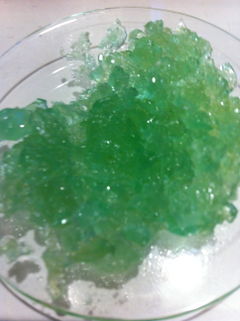Iron(II) sulfate
 Iron(II) sulfate heptahydrate prepared from steel and sulfuric acid (looks more blue in person)
| |
| Names | |
|---|---|
| IUPAC name
Iron(II) sulfate
| |
| Other names
Copperas, ferrous sulfate, green vitriol, iron vitriol, melanterite, szomolnokite
| |
| Properties | |
| FeSO4 (anhydrous) FeSO4·H2O (monohydrate) FeSO4·5 H2O (pentahydrate) FeSO4·6 H2O (hexahydrate) FeSO4·7 H2O (heptahydrate) | |
| Molar mass | 151.91 g/mol (anhydrous) 169.93 g/mol (monohydrate) 241.99 g/mol (pentahydrate) 260.00 g/mol (hexahydrate) 278.02 g/mol (heptahydrate) |
| Appearance | White crystals (anhydrous) White-yellow crystals (monohydrate) Blue-green crystals (heptahydrate) |
| Odor | Odorless |
| Density | 3.65 g/cm3 (anhydrous) 3 g/cm3 (monohydrate) 2.15 g/cm3 (pentahydrate) 1.934 g/cm3 (hexahydrate) 1.895 g/cm3 (heptahydrate) |
| Melting point | anhydrous 680 °C (1,256 °F; 953 K) (decomposes) monohydrate 300 °C (572 °F; 573 K) (decomposes) heptahydrate 60–64 °C (140–147 °F; 333–337 K) (decomposes) |
| Boiling point | Decomposes |
| Monohydrate 44.69 g/100 ml (77 °C) 35.97 g/100 ml (90.1 °C) Heptahydrate 15.65 g/100 ml (0 °C) 20.5 g/100 ml (10 °C) 29.51 g/100 ml (25 °C) 39.89 g/100 ml (40.1 °C) 51.35 g/100 ml (54 °C) | |
| Solubility | Slightly soluble in acids, ethanol, methanol Insoluble in hydrocarbons |
| Solubility in ethylene glycol | 6.4 g/100 g (20 °C) |
| Vapor pressure | 1.95 kPa (heptahydrate) |
| Hazards | |
| Safety data sheet | Sigma-Aldrich (heptahydrate) |
| Flash point | Non-flammable |
| Related compounds | |
| Related compounds
|
Ammonium iron(II) sulfate Iron(III) sulfate |
| Except where otherwise noted, data are given for materials in their standard state (at 25 °C [77 °F], 100 kPa). | |
| Infobox references | |
Iron(II) sulfate, also known as ferrous sulfate is the sulfate salt of the iron(II) ion. It is most commonly seen as the heptahydrate which forms blue-green crystals. It is a brownish-white powder when anhydrous. The old name for the iron(II) sulfate is green vitriol.
Contents
Properties
Chemical
Iron(II) sulfate is an easy source of iron(II) ions in solution, since it is readily available and not expensive.
Upon standing in air, iron(II) sulfate will oxidize to a mixture of iron(III) sulfate and iron(III) oxide because iron(II) compounds are not stable when not kept at a low pH. This can be prevented by adding a small amount of sulfuric acid.
When heated to 680°C, iron(II) sulfate begins to decompose, releasing sulfur dioxide and sulfur trioxide, leaving behind iron(III) oxide.
- 2 FeSO4 → Fe2O3 + SO2 + SO3
It also reacts with hydrogen peroxide, forming Fe(III).
Physical
Iron(II) sulfate is usually seen as the heptahydrate, which forms blue-green crystals. When heated to around 300°C, it loses all of its water of crystallization[1]
Availability
Iron(II) sulfate heptahydrate can be found at some garden stores as soil iron supplement, and can also be bought cheaply online.[2] Its purity when bought can be told by its color, impure samples having a dark green color and brown to gray hue.
Preparation
Iron(II) sulfate can be prepared with iron or steel scraps and dilute sulfuric acid. Concentrated sulfuric acid will not work. If steel is used, the carbon must be filtered out after the reaction is complete. Do not leave the solution to crystallize by evaporation, as the product will become oxidized and impure. Instead, it must be heated without boiling until crystals are visible, cooled, and then dried in a dessicator.[3]
Iron(II) sulfate is produced by addition of metallic iron to copper(II) sulfate. If steel is used, the carbon from steel will leach in the solution, forming a black goo between the copper layer and iron. Copper(II) oxide will also form, which, because it's also black, will make it difficult to determine how much metallic copper was oxidized. Eliminating the air from water prior to the reaction or adding a very small quantity of acid will reduce the formation of the copper oxide and increase the yield.
Projects
- Make Mohr's salt
- Make iron gall ink
- Make iron(III) sulfate
- Grow beautiful crystals
- Make sulfur trioxide
Handling
Safety
Wet iron sulfate should not be handled directly, as it may contain excess sulfuric acid that can burn the skin, if an excess of acid was used. This is not an issue if the sulfate was prepared with copper(II) sulfate and iron metal.
Storage
Ferrous sulfate should be stored in closed bottles, away from moisture. Since it will oxidize in air even when dry, it's best to keep it in air-tight containers.
Disposal
Ferrous sulfate does not require special disposal and can be safely poured down the drain of released in the ground.
References
- ↑ http://en.wikipedia.org/wiki/Iron%28II%29_sulfate
- ↑ http://www.elementalscientific.net/store/scripts/prodView.asp?idproduct=1905
- ↑ http://www.crscientific.com/ferroussulfate.html